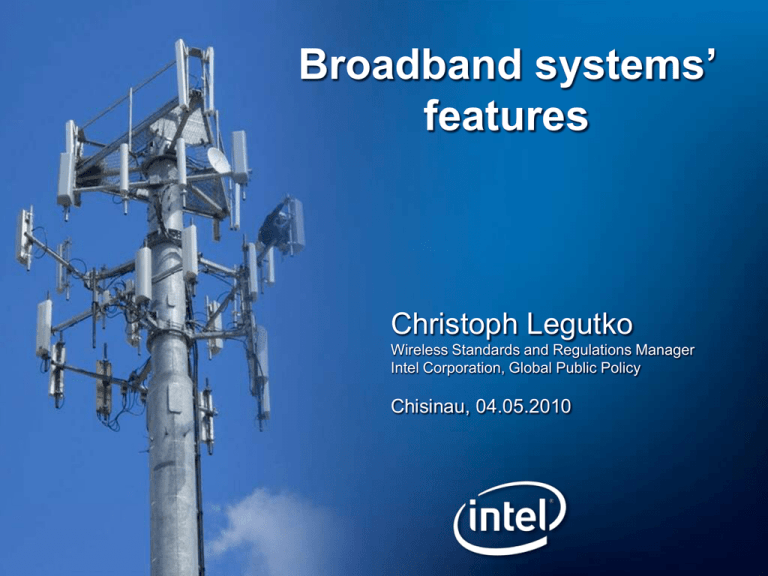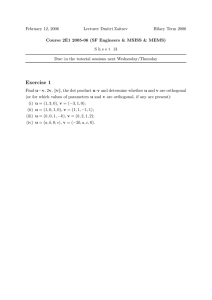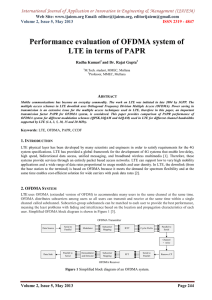Broadband systems’ features Christoph Legutko Chisinau, 04.05.2010
advertisement

Broadband systems’ features Christoph Legutko Wireless Standards and Regulations Manager Intel Corporation, Global Public Policy Chisinau, 04.05.2010 How Will Operators Meet Demand? Global Mobile Data Traffic Growth TB/mo. Independent research firm tests showed an average speed of 3.8 Mbps for downloads and 1.7 Mbps for uploads for the Portland, OR Clearwire network1, four times as fast as current 3G networks.2 2,500,000 2,000,000 The problem with 3G is in the air and the backhaul. The network was built for narrow band and now users are downloading video on iPlayer, on what is essentially a voice network. In London my calls have started dropping and on the motorway my phone drops between cells.3 1,500,000 1,000,000 500,000 0 2008 2009 2010 2011 2012 2013 Source: Cisco Visual Networking Index, July 2009. Forecast, 2008 -2013 [1] Signals Ahead Research, Volume 5, No. 11, 9 September, 2009. [2] Saul Hansell, Sprint Banks on WiMax to Win Back Market Share, New York Times, 27September 2009 [3] “U.S. 3G Networks Deliver Less Than Expected,” Phillip Redman, Gartner Research, 22 January 2009. Mobile Voice vs. Mobile Internet Traffic Equivalents* 1 Smartphone = 30 Handsets 1 Laptop = 450 Handsets ~ 10 Kbps Constant Rate A network optimized for mobile voice cannot handle high numbers of mobile internet users 1-5 Mbps Burst Traffic More Spectrum Needed More Backhaul And Different Network Architecture Required Mobile Internet Requires a Technology Revolution * Source: Cisco Visual Networking Index, July 2009 Broadband Wireless Channel Challenges Frequency variation: – Multipath delay spread at Receiver Time variation: – Mobile stations 4 OFDM Basics • Orthogonal frequency division multiplexing • Frequency-selective wideband channel Parallel orthogonal flat narrowband channels h(t) Subcarrier Cluster t h(f) f 5 f Why OFDM ? • TDMA and CDMA suffers in high delay spread channels • How to combat frequency selective fading? parallel orthogonal flat narrowband channels X dn S / N e j 2 f 1t j 2f 2t e X + sn e j 2f N 1t X IFFT Orthogonal subcarriers → high spectral efficiency FFT fast algorithm → efficient implementation Low data rate on each subcarrier → low ISI – Inter Symbol Interference Combing with advanced FEC – Forward Error Correction →reducing burst errors 6 Cost-effective broadband wireless technology OFDMA – Multi User Access All User 1 User 2 User 3 User 4 • Multiple users keep orthogonal sub-channels during multiple access • Flexible sub-channelization – – Pseudo-random permutation for diversity Contiguous permutation for selectivity • High granularity bandwidth allocation • Scalable structure 7 OFDMA Scalability • CDMA does not scale well with multiple channel bandwidths • CDMA 2000 = 1.25MHz channels • WCDMA/HSDPA = 5 MHz channels • OFDMA allows for optimal operation in varying channel widths • OFDMA = 1.25 MHz, 2.5, 5, 10, 14 and 20 MHz channels OFDMA processing structure scales with bandwidth CDMA optimized for single bandwidth Subcarriers independent over the channel Codes spread over the channel 1.25 5MHz 10MHz 14MHz channel widths 8 20MHz 1.25 MHz 5 MHz channel widths Summary • physical layer uses OFDMA and is optimized for mobile broadband – Robust against frequency-selective fading – Robust against ISI – Multi-user access – High data rate in both downlink & uplink – Efficient implementation – Flexible & scalable architecture – Diversity, AAS - Advanced Antenna System, and MIMO – Inter Symbol Interference 9 Glossary AAS – Advanced Antenna System LOS – Line Of Sight AMC – Adaptive Modulation and Coding LTE – Long Term Evolution AMS – Adaptive MIMO Switching MCS – Modulation-coding scheme ARQ – Automatic Repeat Request MIMO – Multiple-Input, Multiple-Output (Antenna system) BS – Base Station MME – Mobility Management Entity BTS – Base Station Transceiver MS- Mobile Station CC – Convolution Coding NLOS – Non Line of Sight CDMA – Code Division Multiple Access OFDM – Orthogonal Frequency Division Multiplexing CP – Cyclic Prefix OFDMA – Orthogonal Frequency Division Multiplexing (Multiple Access) CQICH – Channel Quality Indication Channel CTC – Convolutional Turbo Code CSI – Channel State Information CSN – Connectivity Service Network DL – Down Link (BS to MS) FCC – Federal Communications Commission FDD – Frequency Division Duplex FEC – Forward Error Correction FFT – Fast Fourier Transform FUSC – Fully used sub carrier HARQ – Hybrid Automatic Repeat Request ISI – InterSymbol Interference LA – Link Adaptation 10 PHY – Physical Layer PUSC – Partially used sub carrier QoS – Quality of Service RRM – Radio Resource Management RX - Receiver SM – Spatial Multiplexing SNR – Signal-t0-Noise Ratio STC – Space-Time Coding SISO – Single Input Single Output TDD – Time Division Duplex TX - Transmitter UL – Up Link (MS to BS) WWAN – Wireless Wide Area Network Thank You


